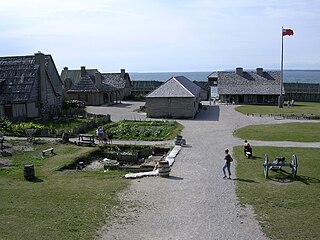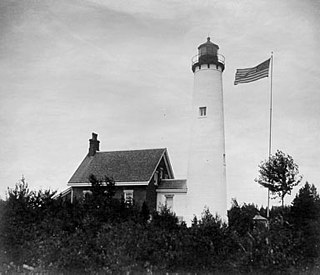
The Mackinac Bridge is a suspension bridge spanning the Straits of Mackinac to connect the Upper and Lower peninsulas of the U.S. state of Michigan. Opened in 1957, the 26,372-foot-long bridge is the world's 24th-longest main span and the longest suspension bridge between anchorages in the Western Hemisphere. The Mackinac Bridge is part of Interstate 75 (I-75) and the Lake Michigan and Huron components of the Great Lakes Circle Tour across the straits; it is also a segment of the U.S. North Country National Scenic Trail. The bridge connects the city of St. Ignace on the north end with the village of Mackinaw City on the south.

Mackinac Island is an island and resort area, covering 4.35 square miles (11.3 km2) in land area, in the U.S. state of Michigan. It is located in Lake Huron, at the eastern end of the Straits of Mackinac, between the state's Upper and Lower Peninsulas. The island was long home to an Odawa settlement and previous indigenous cultures before European colonization began in the 17th century. It was a strategic center of the fur trade around the Great Lakes. Based on a former trading post, Fort Mackinac was constructed on the island by the British during the American Revolutionary War. It was the site of two battles during the War of 1812 before the northern border was settled and the US gained this island in its territory.

Mackinac County is a county in the Upper Peninsula of the U.S. state of Michigan. As of the 2010 census, the population was 11,113. The county seat is St. Ignace. Formerly known as Michilimackinac County, in 1818 it was one of the first counties of the Michigan Territory, as it had long been a center of French and British colonial fur trading, a Catholic church and Protestant mission, and associated settlement.

Clark Township is a civil township of Mackinac County in the U.S. state of Michigan. As of the 2000 census, the township population was 2,200.

The Straits of Mackinac are the short waterways between the U.S. state of Michigan's Upper and Lower Peninsulas, traversed by the Mackinac Bridge. The main strait is 3+1⁄2 miles wide and has a maximum depth of 295 feet, and connects two of the Great Lakes, Lake Michigan and Lake Huron. Hydrologically, the two connected lakes can be considered one lake, known as Lake Michigan–Huron. Historically, the native Odawa people called the region around the Straits Michilimackinac. The Straits of Mackinac are "whipsawed by currents unlike anywhere else in the Great Lakes".

Fort Michilimackinac was an 18th-century French, and later British, fort and trading post at the Straits of Mackinac; it was built on the northern tip of the lower peninsula of the present-day state of Michigan in the United States. Built around 1715, and abandoned in 1783, it was located along the Straits, which connect Lake Huron and Lake Michigan of the Great Lakes of North America. Present-day Mackinaw City developed around the site of the fort, which has been designated as a National Historic Landmark. It is preserved as an open-air historical museum, with several reconstructed wooden buildings and palisade.
M-185 is a state trunkline highway in the U.S. state of Michigan that circles Mackinac Island, a popular tourist destination on the Lake Huron side of the Straits of Mackinac, along the island's shoreline. A narrow paved road of 8.004 miles (12.881 km), it offers scenic views of the straits that divide the Upper and the Lower peninsulas of Michigan and Lakes Huron and Michigan. It has no connection to any other Michigan state trunkline highways—as it is on an island—and is accessible only by passenger ferry. The City of Mackinac Island, which shares jurisdiction over the island with the Mackinac Island State Park Commission (MISPC), calls the highway Main Street within the built-up area on the island's southeast quadrant, and Lake Shore Road elsewhere. M-185 passes by several important sites within Mackinac Island State Park, including Fort Mackinac, Arch Rock, British Landing, and Devil's Kitchen. Lake Shore Road carries the highway next to the Lake Huron shoreline, running between the water's edge and woodlands outside the downtown area.

Les Cheneaux Islands are a group of 36 small islands, some inhabited, along 12 miles of Lake Huron shoreline on the southeastern tip of the Upper Peninsula of Michigan in the United States. The name is French for "the Channels", noting the many channels between the islands in the group. They are about 30 miles northeast of Mackinac Island and about 35 miles south of Sault Ste. Marie. The islands are a popular resort and boating and kayaking area. The nearby communities of Hessel and Cedarville on the mainland offer marinas, camping, lodging, restaurants, and shopping. The Les Cheneaux Islands Antique Boat Show & Festival of the Arts has been held on the second Saturday of each August since 1976 in Hessel. It is the world's largest antique wooden boat show.

Northern Michigan, also known as Northern Lower Michigan, is a region of the U.S. state of Michigan. A popular tourist destination, it is home to several small- to medium-sized cities, extensive state and national forests, lakes and rivers, and a large portion of Great Lakes shoreline. The region has a significant seasonal population much like other regions that depend on tourism as their main industry. Northern Lower Michigan is distinct from the more northerly Upper Peninsula and Isle Royale, which, obviously, are also located in "northern" Michigan. In the northernmost 21 counties in the Lower Peninsula of Michigan, the total population of the region is 506,658 people.

Fort Michilimackinac State Park is a state park in the U.S. state of Michigan. It is located in Mackinaw City along the Straits of Mackinac. The park contains Fort Michilimackinac, which itself is dedicated a National Historic Landmark and Old Mackinac Point Lighthouse as well as the Old Mackinac Point Lighthouse Signal Tower which contains a foghorn.
M-134 is an east–west state trunkline highway in the Upper Peninsula (UP) of the US state of Michigan. It connects Interstate 75 (I-75) north of St. Ignace with the communities of Hessel, Cedarville and De Tour Village along Lake Huron. East of De Tour, the highway crosses the De Tour Passage on a ferry to run south of the community of Drummond on Drummond Island. It is one of only three state trunklines in Michigan on islands; the others are M-154 on Harsens Island and M-185 on Mackinac Island. M-134 is also one of only two highways to utilize a ferry in Michigan; the other is US Highway 10 (US 10) which crosses Lake Michigan from Manitowoc, Wisconsin, to Ludington. Most of the mainland portion of M-134 is also part of the Lake Huron Circle Tour, and since 2015, it has been a Pure Michigan Byway under the name M-134 North Huron Byway.

The buildings of the St Helena Light complex are the sole surviving structures on St. Helena Island, in Mackinac County in the U.S. state of Michigan. The lighthouse on the St. Helena Island's southeastern point was built in 1872-1873 and went into operation in September 1873. It became one of a series of lighthouses that guided vessels through the Straits of Mackinac, past a dangerous shoal that extends from the island.

SS Chief Wawatam was a coal-fired train ferry and icebreaker that operated in the Straits of Mackinac between 1911–1984. Her home port was St. Ignace, Michigan, and she shuttled back and forth during her entire working life between that port and Mackinaw City, Michigan.

The Round Island Light, also known as the "Old Round Island Point Lighthouse" is a lighthouse located on the west shore of Round Island in the shipping lanes of the Straits of Mackinac, which connect Lake Michigan and Lake Huron. It was deemed necessary because the island is a significant hazard to navigation in the straits, and was seen as an effective complement to the other lights in the area. Because of its color scheme and form — red stone base and wood tower — it has been likened to an old-fashioned schoolhouse. Ferries regularly pass it on their way to Mackinac Island, and it is a recognizable icon of the upper Great Lakes.

Marquette Island is the largest of the 36 islands in the Les Cheneaux archipelago of northern Michigan, United States. Located in Mackinac County on the north shore of Lake Huron, the island has a small summer population. It is 6.5 miles (10.5 km) long and 3.5 miles (5.5 km) wide. Its geographic center is close to 45 degrees 57 minutes N., 84 degrees 23 minutes W.

Arnold Transit Company the longest-running ferry boat company serving Mackinac Island in Michigan. In late 2016 Arnold Line's Assets including the boats, docks along with its name were purchased by Star Line Ferry, who continues to operate it today.
The St. Ignace News is a weekly newspaper that covers events in and around St. Ignace and Mackinac County in the U.S. state of Michigan. The newspaper's coverage area includes a substantial portion of the eastern Upper Peninsula of Michigan, including the Les Cheneaux Islands summer resort area northeast of St. Ignace.

The Islington Hotel was a family owned and operated lakefront inn located in Cedarville, Michigan in the state’s Eastern Upper Peninsula. Constructed in the late 19th century, the facility lodged and entertained summer guests for more than 60 years with a tradition of friendliness and graciousness. During its heyday it was considered to be one of the finest seasonal hotels in the Upper Midwest.

Due to its unique geography, being made of two peninsulas surrounded by the Great Lakes, Michigan has depended on many ferries for connections to transport people, vehicles and trade. The most famous modern ferries are those which carry people and goods across the Straits of Mackinac to the car-free Mackinac Island but before the Mackinac Bridge was built, large numbers of ferries carried people and cars between the two peninsulas. Other ferries continue to provide transportation to small islands and across the Detroit River to Canada. Ferries once provided transport to island parks for city dwellers. The state's only national park, Isle Royale cannot be reached by road and is normally accessed by ferry. The largest ferries in Michigan are the car ferries which cross Lake Michigan to Wisconsin. One of these, the SS Badger is one of the last remaining coal steamers on the Great Lakes and serves as a section of US Highway 10 (US 10). The Badger is also the largest ferry in Michigan, capable of carrying 600 passengers and 180 autos.

Wawatam Lighthouse is an automated, modern lighthouse that guards the harbor of St. Ignace, Michigan in the Straits of Mackinac. It was originally erected near Monroe, Michigan as an iconic roadside attraction in 1998, and was first lit as an aid to navigation in St. Ignace in August 2006.
















